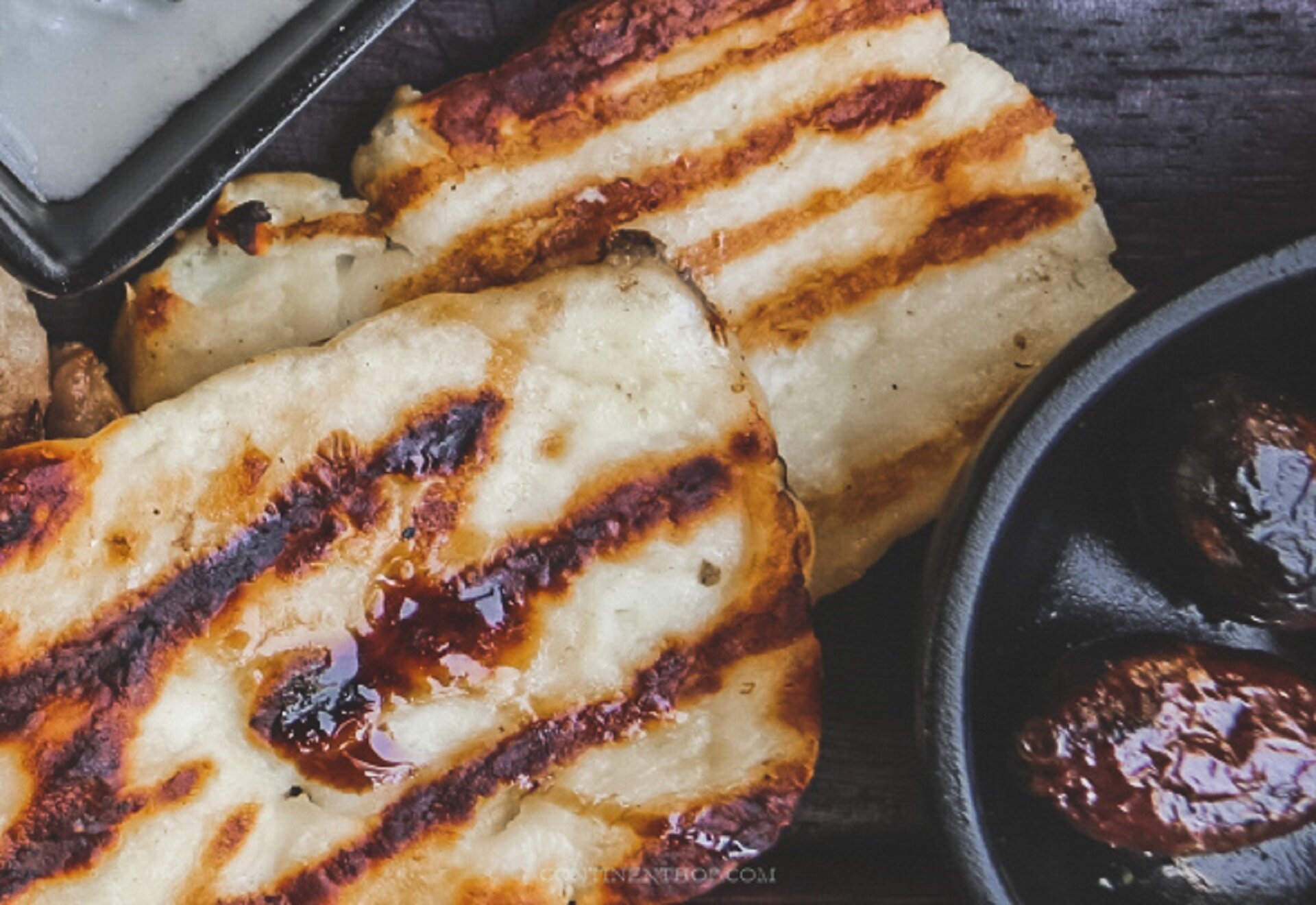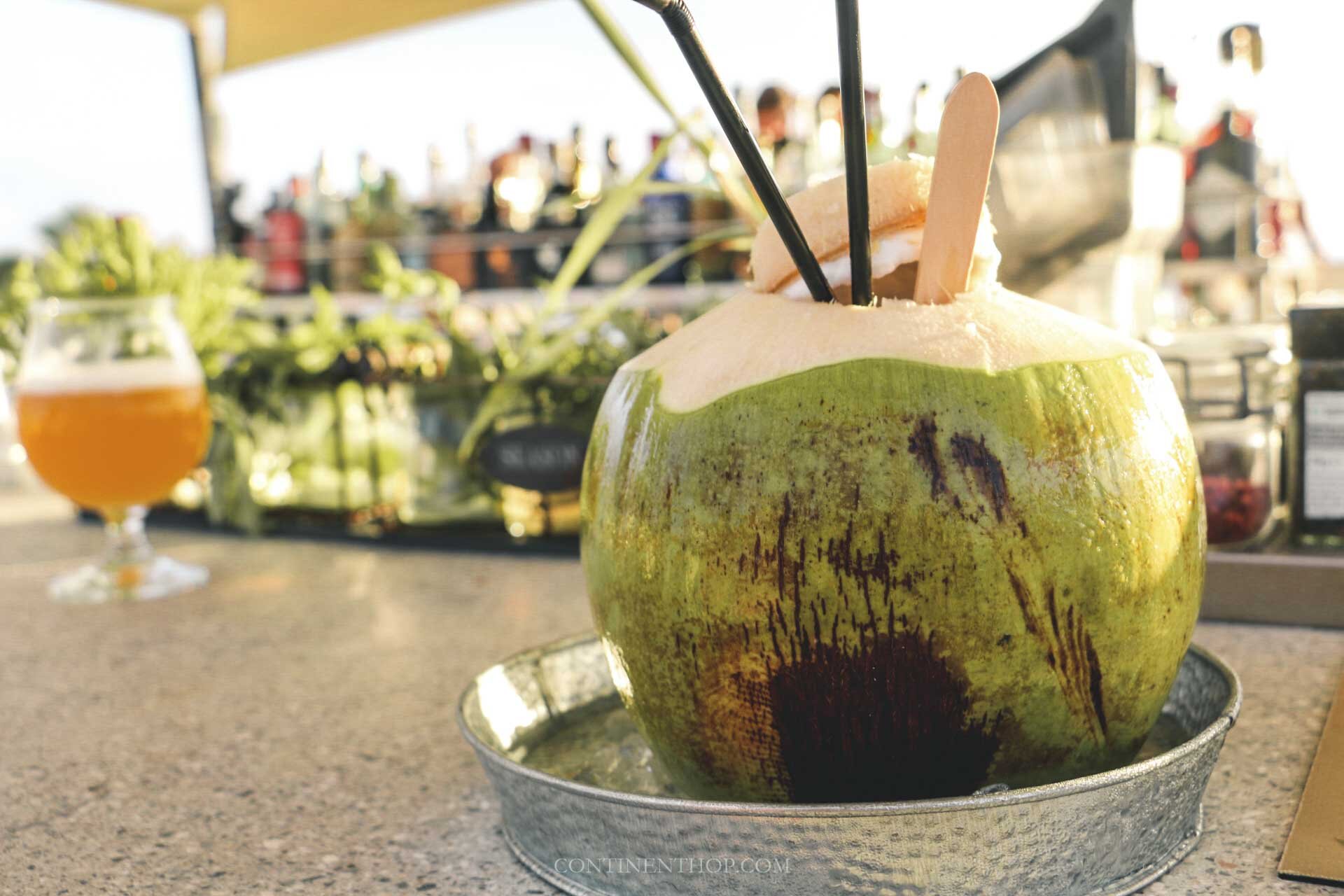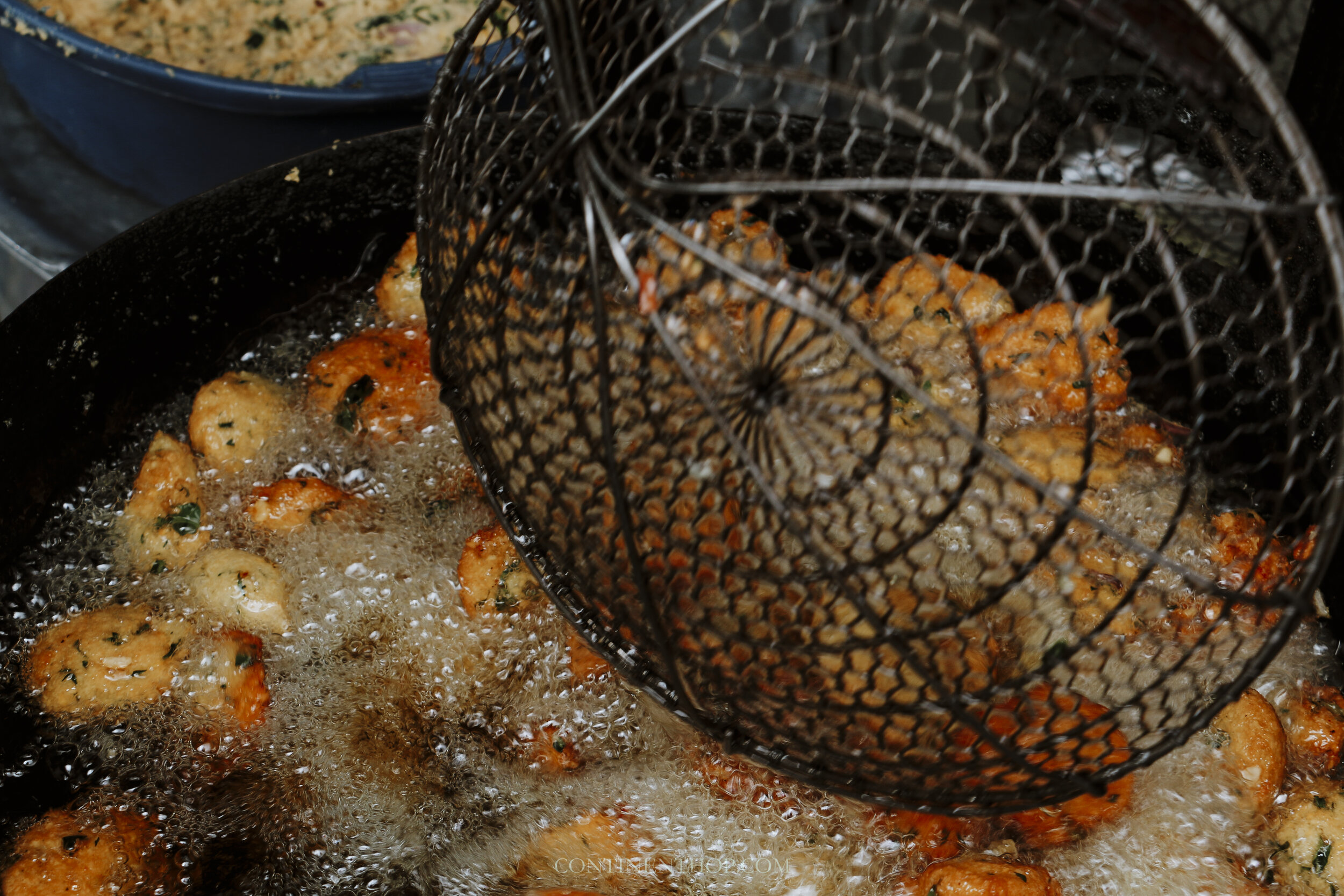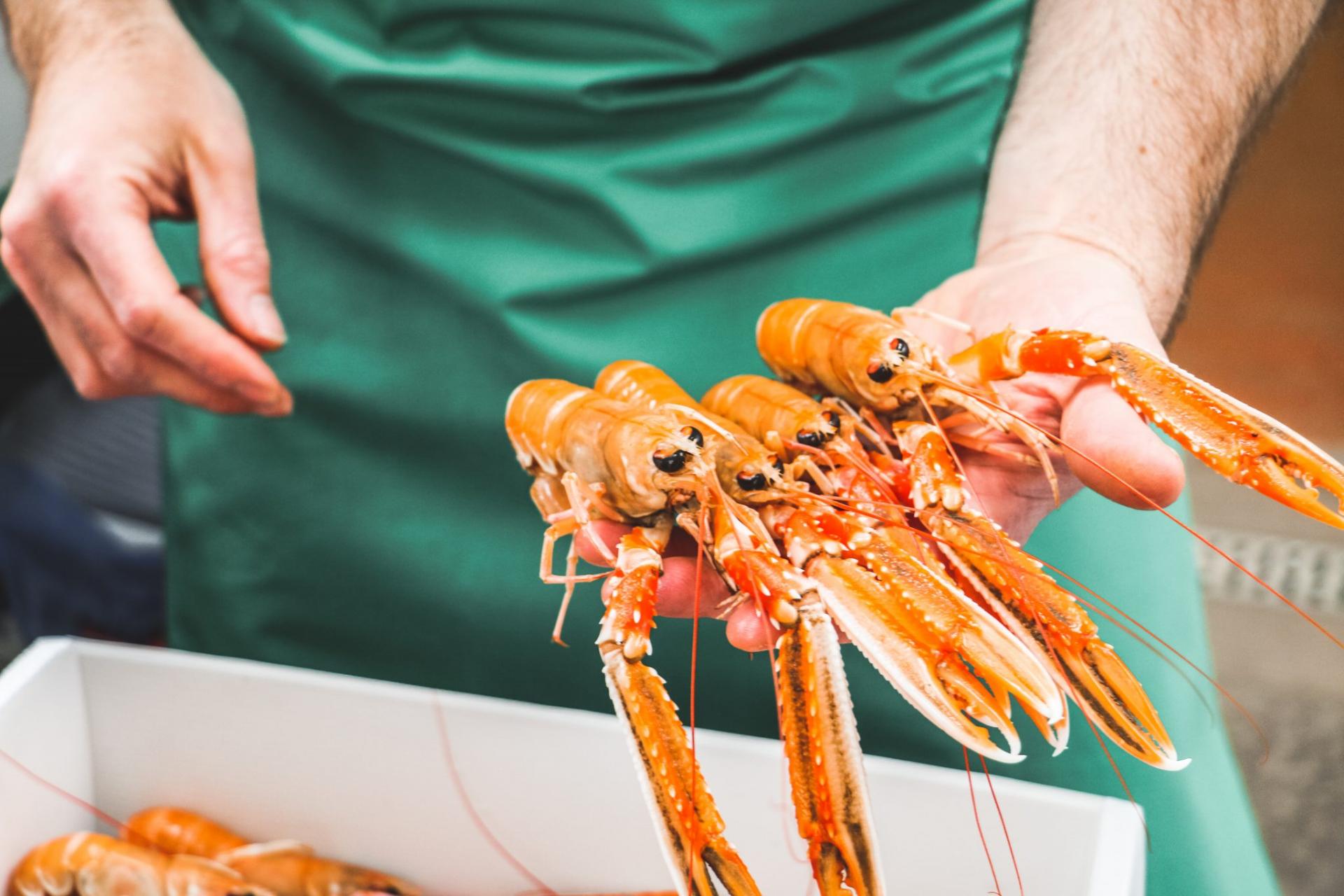
Tasting the traditional food in Cyprus is one of my favorite parts of traveling there. I love authentic Cypriot dishes. They use simple ingredients but have influence from numerous regions nearby that create complex flavors in every dish.
If you’re looking for the best traditional Cyprus food to try on your visit to the Mediterranean Island, here are the best foods, dips, desserts, and Cyprus meze to try!
The evening we arrived in Cyprus, all we had time to do was get something to eat before the restaurants closed for the day. We quickly changed, left our luggage in the room, and picked the restaurant that was closest to the hotel.
I didn’t check the reviews or the menu. I just knew I needed food!
But I got really lucky because The Ficardo ended up being way more impressive than what I expected. They had all the staple Cypriot dishes, but we ordered Stifado and Kleftiko, which was the best meal we had on our visit to Cyprus.
Not Many people visit Cyprus for the food, but that’s one of the biggest reasons I can’t wait to return! Traditional food in Cyprus recipes is influenced by Greek, Byzantine, French, Italian, Catalan, Ottoman, and Middle Eastern cuisines. It’s truly a melting pot and produces some incredible dishes!
This list will help you understand exactly how each dish is prepared so you don’t feel lost next time you order a meal in Cyprus!
Traditional Food in Cyprus: Must-Try Dishes
Includes Cypriot meze, salads, dips, drinks, sweets and desserts
BEST APPETIZERS AND MAINS
1. Stifado
Since Stifado is what I had on my very first evening in Paphos, Cyprus, it’s right to start this guide of Cypriot dishes you need to try with this.
Stifado is one of Cyprus’ famous foods with Greek Origins. However, no tomatoes are added to the Cypriot version. Instead, there are lots of pearl onions, vinegar (as I’d noticed from my first bite), garlic, red wine and, the main spices are cinnamon, bay leaves and, peppercorns.
It reminded me of Sorpotel, tangy with a hint of vinegar somewhere, the right amount of spice but not hot. It did seem it wasn’t fried like you need to for Sorpotel but had been slow-cooked for a long duration, which made the meat really tender.
In Cyprus, Stifado – also spelled ‘Stiffado’ – is usually prepared with wild hares or rabbits. It can be even made with tripe, octopus, beef, veal, and the vegetarian version, with chestnuts.
It’s the perfect comfort dish for a cold winter’s evening, but I had no regrets about having it in August as it’s a favorite in Cyprus. The dish is usually served with pilaf, potatoes, or Bulgur wheat, which is similar to couscous.


2. Kleftiko
We’d ordered Kleftiko with the Stifado, and it was the perfect combo. Not because the two are to be had together but because the Kleftiko is as equally comforting as Stifado. Kleftiko is another dish that is slow-cooked. The leg of lamb is cooked for about four to five hours. Sometimes potatoes go underneath it and turn out tasty, too!
Kleftiko is made from lamb and has Greek origins, too. The name originates from the Klephts or kléftes, which means “thief,” who were anti-Ottoman rebels located in Ottoman-occupied Greece.
These mountain inhabitants were also ‘sheep-thief’ viz. sheep rustlers, who used to steal lamb, then bury it in a pit to bake it whole after covering the makeshift oven with earth so that the smells wouldn’t escape. A traditional round, white oven or a mud stove is used nowadays.
The marinade is a mix of bay leaves, garlic, herbs, lemon, salt, and pepper, which is then poured over the lamb, and the lamb is then left inside the fridge to marinate overnight or at least for four hours. A different method also uses wine in the marinade, which makes it different from Greek cuisine.
It then goes in the oven, covered in parchment paper or foil, and the oven does all the work for you. It is ready when you can use a fork to easily pick pieces of the meat off the leg.
Mostly served at family get-togethers and special occasions, it can be sometimes shredded to pieces and served with any accompaniment like Bulgur wheat, but usually it’s the potatoes.


3. Chirino me Kolokassi
Taro has been used by Cypriots for ages. Taro or elephant ears do not look like potatoes but definitely taste like it and are prepared the same way, too. Taro is used widely in Asia, Oceania, Africa, and some parts of Europe. Baby taro are called ‘poulles’ and are shallow fried in the shape of fries.
Taro goes well with pork, chicken, or beef, but Chirino me Kolokassi is pork with taro, where taro and meat are first fried together well, after which the spices, tomato, and celery are added to it.
This dish, part of typical Cypriot food, is then left to simmer till all of the ingredients become tender.
Chirino me Kolokassi is a very hearty dish, which makes it perfect for winter. However, it can be a little difficult to find the dish during summer.

4. Afelia / Afella
Another food from Cyprus with Greek origins, Afelia, was the equivalent of Ovelia in Greece, which meant cooked meat. In Cyprus, Afelia is made from pork marinated in red wine. While it has Greek origins, it is a staple of traditional Cyprus cuisine.
The main spice that is used in Afelia is coriander seeds. Batches of pork are boiled with the spices till the water dries out and then lightly fried in a tava, similar to a saucepan, in olive oil before the wine is added to it. The spices used most often are coriander seeds, which are a must, pepper, bay leaves, garlic, and cumin.
The dish is ready when the wine that is added to it gets evaporated, too. Usually served with rice.

5. Moussaka
Anyone who’s heard of Greece and likes world food would have heard of Moussaka. Surprisingly, I had one of the best Moussaka of my life in the Akamas Peninsula in Cyprus at a place called Polis.
Polis is renowned for its herb garden, and they cleverly use most of them in their dishes. The moussaka I had here was aromatic, and I hungrily scraped the last bits of it from the clay pot it is usually served in.
While the dish is synonymous with Greek cuisine, its origins are believed to be from the Levant region from a dish called musakhkhan. Musakhkhan or Mussakhan is roasted chicken baked with onions and spices over Taboon bread. A Greek chef, Nicholas Tselementes, who had worked at renowned restaurants around the world, including the Hotel Sacher in Vienna, added the layers and the bechamel sauce to it to make it more European.
Moussaka has eggplant, potato, and minced meat as the main ingredients. It is covered with a thick layer of béchamel sauce that turns crispy and golden.

6. Tiropittes / Tiropitas
If you’re wondering what to eat in Cyprus when you don’t have much time, Tiropittes are a great option!
It’s an appetizer made from phyllo pastry and a cheese and egg mixture – so essentially, a feta cheese pie. They are usually served before a meal or as a snack, and I love grabbing one while exploring the Paphos for the day.
Sometimes, bechamel sauce is also added to the cheese mixture to make it even more creamier. They are served either as individual triangles or a whole batch in a casserole dish and cut up into squares.
You can also buy them frozen and cook them in the oven back at your Cypriot Villa.
7. Gemista
Gemista always reminds me of stuffed bell peppers (a.k.a. capsicums) I had as a child, but these were stuffed with either chickpea flour or minced meat.
Gemista or Yemista translates to ‘stuffed’ in Greek. It can be not only peppers but also tomatoes, zucchini, and eggplant that are stuffed with rice, minced meat, or a mix of both and then baked in the oven till browned. It also
The rice needs to be cooked thoroughly so that it’s not al dente, but it needs to be done with the peppers and not separately so that the rice absorbs the flavors of all the ingredients and spices. It also needs to have oodles of olive oil, which makes it wrinkly once done. Locals say that if the dish looks great, it probably won’t taste that good!
The traditional version is apparently vegetarian, where no meat is used. Almost every household has its own family recipe for it, and meat is generally used in winter to make it hearty. The dish can be served by itself or as an accompaniment with meat.

8. Souvla
Souvla, not to be confused with Souvlaki, is the Cypriot version of the Greek dish, with the meat cuts being larger and slow-cooked for a longer time. In Greece, Souvla means ‘spit’ (like the fire), and a souvla is roasted lamb.
There is more distance between the meat and the charcoal barbecue, and the chunks are spaced uniformly so the meat cooks evenly. The cuts are usually from the neck and shoulder of lamb, pork, or chicken.
Once the Souvla is cooked, the meat is brought closer to the charcoal to brown it a little.
Souvla, like Gemista, has many variations, and the type of meat, as well as the spices that go on it, can vary from region to region. Black pepper, garlic, onion, dry parsley, oregano leaves, and freshly ground coriander seeds are the spices most commonly used. It is a popular meal for festive occasions as families come together to grill the meat.
Souvla is similar to Indian ‘tikka’s’, where chunks of meat are marinated, sometimes overnight, and then grilled or barbecued. However, the yogurt is mostly absent.
Souvla can also be added to pita bread with a pocket, which is thinner and larger in Cyprus, with salad and dips like tzatziki to make a summery sandwich. It is street food in Cyprus but can be found in all restaurants and taverns.

9. Spanakopita
Another food item with Greek origins, Spanakopita, cannot be considered traditionally Cypriot it is still very popular among the locals. A delicious layered savory pastry made of phyllo (filo) or puff pastry and stuffed with spinach, feta cheese, spring onions, and egg, it tastes best when hot.
Different Greek islands make it in their own way. But proper homemade spanakopita also involves using ‘village dough’, which is slightly thicker than phyllo pastry sheets.
It can be made vegan, too! You just have to replace the cheese with tofu.
Since spinach already contains a lot of water, the excess must be squeezed out either by adding salt to it and leaving it for a while or boiling it for a short duration and then squeezing the water out later. The puffs are very versatile and can be had at any time of day, including tea.
10. Ttavas
Ttavas is associated with a lovely village in Cyprus, Lefkara, popular for its traditional lace. Here it is called Lefkaritikos Ttavas.
Ttavas, means a ‘clay pot’ where the meat, lamb or goat, is placed together with rice and vegetables, usually onions, tomatoes, and potatoes. Cumin is one of the most important spices in Ttavas. Then add pepper and vinegar. before adding enough water to cover the ingredients, covering it with foil, and baking it for about 4 hours.
It’s a dish packed with flavor as all the ingredients cook together, imparting a unique flavor. Each region uses a different mix and quantity of vegetables, which makes it even more distinct.

11. Macaronia tou Fournou/ Makaronia tou Fournou
Oven-baked macaroni in Greek is the Cypriot version of pastitsio. What makes it different, though, is that halloumi is used in place of the usual variety of cheese, parmesan, that is used in pastitsio.
The mince is not cooked in tomato sauce, which makes it different from pastitsio.
Makaronia tou fournou means ‘pasta baked in the oven,’ the pasta tubes are layered with cheese and minced pork meat and then placed in a large oven until it is browned. Sometimes, cheese is sprinkled on the top to make it crispy.
This layered pasta dish also contains bechamel sauce, and mint is used liberally for seasoning.
12. Kolokouthkia
Courgettes, fried together with scrambled eggs in olive oil, are usually part of a Cyprus Meze platter. They also add traditional Cypriot spices, mint, lemon, and pepper most of the time.
As it is so simple to make, locals make it for breakfast or when they are running short on time. A great option for vegetarians and people who like eggs.
At restaurants, it’s not really a full meal, but a popular meze served with a side salad.

13. Loukaniko
Traditional Cypriot sausages, Loukaniko, have an unmistakable flavor of fennel. A thin, long sausage with Greek origins, the minced meat is marinated in red wine with some salt. Pepper, cumin, and coriander are added to it (as with most Cypriot dishes). Then it’s made into sausages, smoked, and dried.
The sausages can be grilled, fried, or barbecued and served as part of a Meze.
Invented as long ago as the 3rd century BC in a place called Lucania, Loukaniko has a dried berry called “schinia” (Cypriot berry that looks like pink pepper) added to it. I found many Mastic trees, on which Schinia grows, on the walk to the Baths Of Aphrodite on the outskirts of the Akamas Peninsula National Park.
These trees are found throughout Cyprus.
The addition of the wine makes them look slightly purple, and the spices make them spicy and tasty.

14. Cypriot Meze Foods
The Meze in Cyprus (a.k.a. ‘small dishes’) is perfect for anyone wanting to try various options before committing to a meal. It’s also sharable, so it’s great to order a Meze Platter for the table so that everyone has something to snack on before the first course.
Sometimes, main courses can also be served as part of a meze, albeit in a smaller quantity. It may also contain salads and desserts.
Meze has Persian origins. However, many countries in the Middle East and the Mediterranean have their own meze platters that serve the best traditional dishes. It is similar to tapas in Spain.
A Meze will have anywhere from 5-20 dishes, depending on what you choose. Expect pita bread and a variety of dips such as tzatziki, taramosalata, and hummus. Ouzo and Arak are the best drinks to have with a meze.
It’s also quite common to get some meats with your meze, too. For example, Keftedes (Greek Meatballs) are commonly included in a Cypriot meze platter!
15. Fried Halloumi Cheese
A highly addictive food from Cyprus, this brined cheese is made with a mixture of goat and sheep’s milk, which has a very high melting point that’s ideal for grilling or frying.
Set with rennet, the absence of bacteria makes it very unusual and reminds many of mozzarella. Over time, due to increased popularity, cow’s milk is also being used in sparse proportions.
White in color, rubbery, and salty, it has no distinct flavor, which makes it the perfect addition to almost anything, including soups, salads, sandwiches, and meals.
Believe it or not, hot Halloumi goes really well with watermelon.

16. Sheftalia / Sheftalies
Sheftalia or sheftalies are traditional kebabs from Cyprus without skin that use caul fat to form the sausages. Ground meat (mostly pork) is added to finely chopped onion and parsley with salt and pepper and formed into small kebabs.
They reminded me of cevapi from Romania, which were equally flavorful and had no skin.
Sheftalia comes from the Turkish word şeftali (kebab), but şeftali means peach in Turkish. This is because in Persian, the same word means a ‘fat berry’, and since fat is used in the making of this kebab, hence the name!
Shoulder cuts high in fat are used so that the kebabs stay juicy when cooked by grilling or frying. A mixture of lamb and pork can also be used. Caul fat is easier to use than sausage casings, doesn’t have a ‘meaty’ smell to it, and looks like a spider’s web. It is also almost as thin as parchment paper.
The sheftalies are mostly grilled and, once done, browned, which makes them very crunchy from the outside and juicy inside. Like Souvla, they can be added to a pocket pita bread with salad to make a sandwich.

17. Koupepia
Stuffed vine leaves, popularly called Dolmades (plural of Dolma) in Greece, are the inspiration for Koupepia, although its origins are from the Middle East.
Dolmades are vine leaves (grape leaves) that are stuffed with the main elements of rice and ground meat. The Cypriot version adds a sauce of tomato, herbs, and cinnamon to it, which makes it unlike dolmades, as dolmades are served with avgolemono sauce, made with egg and lemon.
The vine leaves are first blanched, and then the stuffing is then added to the vine leaves and carefully wrapped before steaming.
The vegetarian version, served at Lent, is made without using meat.
18. Koupes / Koubes
Croquettes shaped like torpedos, Koupes are another dish originating from the Levant region.
Minced meat, parsley, onion, and spices are stuffed inside a casing made of Bulgur wheat, flour, and egg and then fried. The casing is made by making a roll, then squeezing one end shut, and then adding the stuffing from the other before closing it.
Koupes are also popular as street food and can be made into a vegetarian version, too. The meat is simply replaced with mushrooms. Like spanakopita, many people consider koupes part of Cyprus snacks that you can have throughout the day and are served with lemon wedges and a salad if had as a main meal.

More Traditional Cypriot Dishes
ACCOMPANIMENTS, SEASONINGS, SALADS, AND SOUPS
19. BULGUR
Bulgur is mostly made from durum wheat and is served as a side dish like couscous and rice, with most of the meals described above. It is also used to make pilafs, make koftes, and is added to Cypriot salads and soups.
One of the most simple Bulgur dishes is Pilafi Pourgouri, made from bulgur with tomato juice and onion. It’s healthy but a poor man’s dish in Cypriot cooking as a poor man’s dish.
20. PITA
Pita or pitta bread is a flatbread made from wheat flour originating in the Middle East. It is yeast-leavened and is used commonly in Cyprus. Pita with pockets is used to make sandwiches in Cyprus by using Souvla or Sheftalia.
21. LOUVI
Louvi is a traditional Cypriot salad made from black-eyed peas with garlic, onions, parsley, and silver beet or Swiss chard. Seasoned with salt, pepper, and olive oil. The dish is very nutritious, high in protein, and is great during the summer months.
It is a staple in Cypriot houses, and tomato and cucumber are served on the side with Louvi.
In addition to these food items, olives, olive oil, artichokes, and chickpeas are a staple in every Cypriot household.
The spices and seasoning used most commonly in Cypriot cuisine cooking are coriander seeds, lemon, mahlepi (mahlab) – a Middle Eastern spice made from ground cherry pits that taste similar to marzipan. Carob syrup is used occasionally as a drizzle on desserts and cheese and in salad marinades.
As for Cypriot soups, Trahana is often added to soups. Trahana is made by boiling bulgur in sour milk till cooked and then left to dry. Trahana can then be added to any soup. This makes it one of my favorite things to bring home from Cyprus as a souvenir.

DIPS
Almost all of these dips are served as part of a meze platter and go really well with grilled meat, salads, and pita. They go really well when making a pita sandwich.
22. TALATOURI (TZATZIKI WITH MINT)
This traditional Cypriot dip is made by using either fresh or dry mint and lemon juice in place of vinegar. This is what makes it different from Tzatziki. These ingredients with lots of garlic olive oil are added to hung/strained yogurt or creamy Greek yogurt to make talatouri. Seedless cucumbers are grated and then added so are to keep the texture creamy.
23. TARAMOSALATA
Only seafood-loving folk will like this dip as this one contains smoked fish roe with garlic, parsley, lemon, grated onions, and bread all blended together. It’s best to make and have it fresh, as sometimes food coloring is added to tinned taramosalata. Roe of cod is mostly used.
24. TIROKAFTERI
This spicy feta cheese dip/spread is made smooth by adding milk to the cheese and then mixing it well. Chilies, lemon juice or vinegar, garlic, oregano, and olive oil are also added to this dip, which is also used as a marinade for meats in some regions.
25. HUMMUS
The famous hummus is also served at most places. As mentioned previously, chickpeas are a staple here, and the influence of Middle-eastern cuisine here makes it obvious.
For those who haven’t heard of hummus before, it is a dip that originates from the Levant region and is made by mashing chickpeas with olive oil, garlic, lemon juice, salt, and tahini.
26. TAHINI
A creamy sesame butter when used as a dip, tahini has garlic, onions, and lemon juice. Tahini is added as a condiment to hummus, falafel, and babaganoush. Honey can also be added to tahini and drizzled on desserts as a sweet alternative.

DESSERTS IN CYPRUS
27. BAKLAVA
Synonymous with the Middle East, Baklava is a traditional pastry made with phyllo (filo) or layers of unleavened dough with chopped nuts and honey in between. It is extremely popular in Turkey and parts of Cyprus.
28. LOUKOUMI
For anyone who has ever had Turkish delights, Loukoumi should taste no different. Made from starch of gel and sugar, these chewy treats dusted with powdered sugar (to avoid sticking to each other) come in various flavors (my favorite being rose) and are available almost everywhere in Cyprus. Traditional flavors have no chopped nuts or dates added to the cubes.
29. KOULOURAKIA
Kolourakia are pastries that are hand-shaped, usually in the form of twisted wreaths, figure eights, horseshoes, or circles. They are butter-based and may sometimes have sesame seeds sprinkled over them. They taste great with tea and can usually be found during Easter time.
30. GLYKO TOU KOUTALIO
These candied preserved fruits or vegetables are extremely sweet and are usually served to guests on a small spoon with a glass of water. Glyka, often known as ‘spoon sweets,’ are flavored with cinnamon, vanilla, and sometimes geranium.
Figs, cherries, citrus peels, watermelon rind, and nuts are some of the commonly used items, and the process of making Glyka is similar to marmalade. It’s another great souvenir to take back home or as a gift!
31. PASTELLI
A traditional Cypriot sweet made from Carob syrup, carob syrup is boiled till it reaches the desired consistency and then twisted and shaped by hand. It is often made in the summer months as it is easier to mold it without the mixture cooling faster.
To this day, the village of Anogyra in Limassol still continues to make homemade Carob syrup and pastelli in the traditional way.
32. EKMEK KADAYIFI
Made from rusk-like bread and topped with whipped cream, Ekmek Kadayifi is a dessert with Turkish origins. Is it simple to make, and the bread almost always gets soaked in a caramel ‘serbet’ (sherbet) before being served.
33. LOUKOUMADES / LOKMA
Dough balls are deep-fried and then soaked in sugar syrup or honey. Cinnamon, crushed or flaked nuts, sesame, and powdered sugar are used to generously coat them. They look like gulab jamuns (for those who have tasted this Indian sweet) and taste like doughnuts coated in honey.
They are always light and spongy in texture, while the size of the dough balls can vary.

DRINKS
COCONUT WATER
I was excited and quite happy to find coconut water in Cyprus. While many may assume that the numerous beaches in Europe warranty countless coconuts, unfortunately, it isn’t so in all countries. It came in a tray with ice and kept it cold, which made me quite happy!
FILTAR
Traditional Cypriot liqueur flavored with a blend of aromatic herbs and sun-ripened orange. The family recipe has been passed down from the 13th century and was obtained by the owner’s ancestors, who got it from a monastery in Kantara. Great as an aperitif.
COMMANDARIA
A dessert wine that is amber-colored, it is made in the foothills of the Troodos mountains in the Commandaria region of Cyprus. It has a high alcohol content and is believed to be the oldest named wine still in production. It has been mentioned as far as 800 BC.
ZIVANIA
A Cypriot pomade brandy made from distilling a mixture of grape pomace (the pulp left after extracting juice) and local dry wines. It is colorless and smells of raisins. Zivania (a.k.a. ‘firewater’) has a higher alcohol content than most other drinks in Cyprus.
It is used by locals to treat some wounds, massage sore body parts, and as a remedy for colds and toothaches.
OUZO
A dry anise-flavored aperitif, Ouzo is not native to Cyprus but can be found in a few European countries. It tastes similar to Arak and Sambuca. Served as shots in small glasses or can be mixed with a small amount of water, too.
All of these traditional drinks act as lovely Cypriot products to take back home as gifts!


Best Places to Eat in Paphos, Cyprus
Food in Paphos is just like any other part of Cyprus, and here are some great restaurants to have it! If you’re looking for where to eat in Paphos, make a note!
A great find, a short walk away from the sea, located near SODAP beach. Lovely atmosphere, and the restaurant is open till late.
The best bit is that almost all dishes are super tasty and priced well, too. Do not miss out on the traditional Cypriot dishes.
OUZERI
Hands down, one of the most romantic restaurants in Paphos. Located right next to the sea, they have live music in the evenings. The food is delicious. The restaurant may not be placed in the budget category, but it is worth it. Opt for the fresh seafood.
LAONA
Laona was the best restaurant to try meze. It’s budget-friendly yet really tasty, and the service was great, too. By the time we were done, we had tasted almost all the traditional Cypriot foods. The meze also had dessert included. Included in town, it’s a great stop when exploring the city of Paphos or searching for street art.
Cyprus is a favorite with holidaymakers, who love it for the beach and the countless hours of sunshine, but there’s hardly anything said about the food here, which can be simple yet tasty and quite hearty too.
The taverns here have a rustic look and serve street food in addition to the traditional items and are great if you’re looking to have a quick meal or a drink within budget.
Make sure you try the cuisine in Cyprus, as there are few places in the world where you can have an amazing meal while listening to the sounds of the sea and watching the moonlight twinkle on the waves, and Cyprus does not disappoint!

Traditional Cyprus Food: FAQs
WHAT IS TRADITIONAL FOOD IN CYPRUS?
There are many traditional foods in Cyprus that you should try, but the ones that are most well-known are Souvla, Koupepia, Halloumi Cheese, Afella, Stifado, and Loukoumades.
WHAT IS THE MOST POPULAR FOOD IN CYPRUS?
The most popular food in Cyprus is Souvla. You can find these meat skewers on almost every menu, and it’s common for them to be the primary dish at larger family gatherings in Cyprus.
A traditional Cypriot breakfast typically is a platter of local produce. This includes fresh bread, Halloumi cheese, fried eggs, Anari (traditional cheese), Elies Tsakistes (crushed olives), and cured meats. There is also marmalade (various fruits), and everything is served with roasted Cypriot coffee.
IS CYPRIOT FOOD DIFFERENT TO GREEK?
Yes, Cypriot Food is different from Greek food. While Cyprus has a large portion of ethnically Greek citizens and shares a lot of Greek Culture (especially with the cuisine), most dishes are not exactly the same and have slightly different ingredients or recipes that make the food unique to Cyprus.
Final Thoughts: Best Traditional Food in Cyprus
If you are traveling to Cyrpus anytime soon, you’re in for a treat (literally)! The food here is delicious, and you’ll never run out of new dishes to try. It’s also very unique. Most of the dishes resemble something you might find in Greece, Turkey, or Egypt, but when it’s prepared using traditional recipes and local ingredients, it becomes a completely new dish!
My favorite traditional foods in Cyprus will always be Stifado and Kleftiko. That’s probably due to a bit of nostalgia since it was my first meal in Cyprus, but it’s also a local favorite and something that everyone should try at least once when visiting the island.
No matter what you order, once you finish eating, be sure to check out Edro III Shipwreck near Paphos. This is a great addition to your travel plan, whether you spend one day or 7 Days in Cyprus!


What’s the best cuisine you’ve ever tasted? I’d love to hear them in the comments below!
EXPLORE MORE FOOD IN EUROPE
Featured

Some of the links on this post are affiliate links. These do not cost you extra to use, but will help provide Continent Hop with a small commission if/when you purchase through them, to recover some of the costs of running this website and providing free content to help you plan your travel. I appreciate your support!







